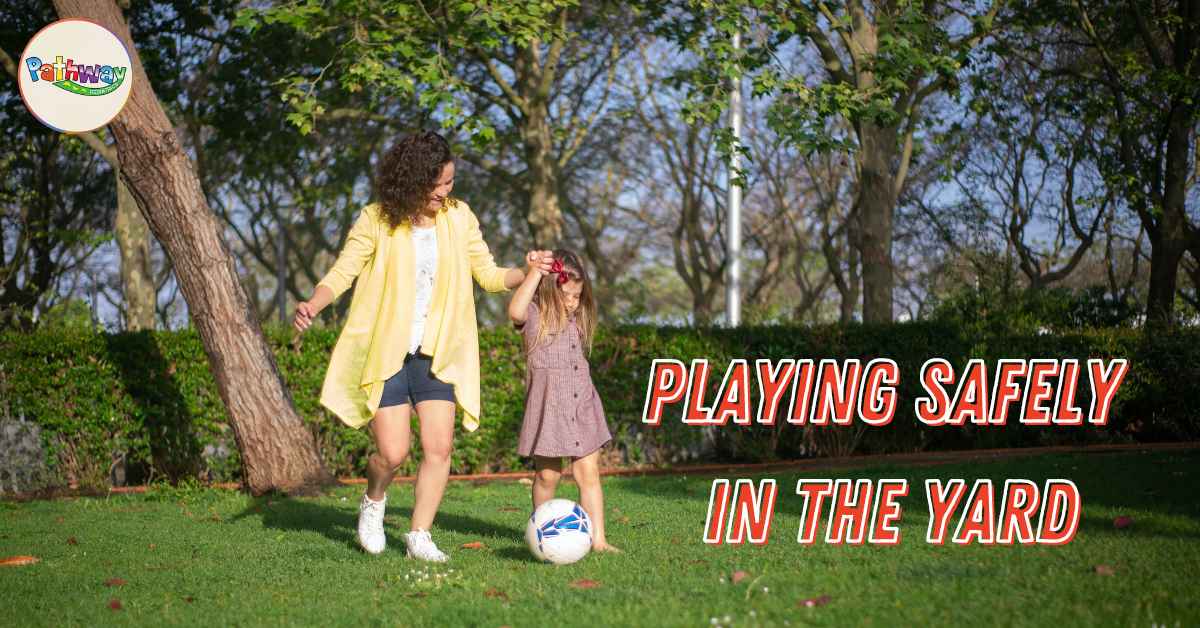Playing Safely in the Yard
April 12, 2023

8 Tips to Keep it Safe & Fun for Kids
As springtime is in full bloom and the weather warms up, it’s always good for kids to get out of the house and play outside! If you have a backyard or other outdoor space at home where your kids play, follow these tips to help keep them safe while they’re having fun!
Keep Little Ones Close
Make sure you (or another adult) are watching closely so younger children don’t wander off or up the swingset alone or play near the street. We know it can be tempting to run into the house quickly for sunscreen or to refill a water bottle, but the safest move is to bring your child with you. And whether they are young or older, make sure your kids take regular breaks to hydrate and reapply sunscreen, especially during peak sun hours.
Use Safety Layers Around Pools and Hot Tubs
Drowning is the top cause of death among children under 4 years old. Provide constant, touch supervision around pools, hot tubs, ponds and other bodies of water. Many tragedies happen in home swimming pools when children wander outside without adults. If you have a pool, it should have a four-sided fence at least four feet tall, with a self-closing, self-latching gate to prevent children from slipping into the water alone. Other safety layers, like locked doors and alarms that detect when someone enters the area or falls in the water, also help prevent the unthinkable.
Set Up Home Playground Equipment Securely
Anchor large home playground equipment deeply and securely to avoid tipping. Install swings at least 6 feet away from walls and fences. Look for openings in play structures, such as spaces in cargo nets, which should be less than 3 ½ inches or more than 9 inches wide. This can keep a small child’s head from getting trapped while preventing kids from falling through. Lay a 12-inch base of sand, mulch, or wood chips under play structures, or use safety-tested playground tiles or mats (though grass may seem soft, it can’t absorb the shock of a child’s fall). Keep an eye out for loose connections, sharp edges, splinters, peeling paint and other hazards.
Use Extreme Caution With Trampolines
Trampoline jumping can result in broken bones, concussions, sprains, bruises and scrapes, as well as serious head and neck injuries that can cause paralysis or death. In fact, the risks are so great that we recommend against home trampolines. If you own one, use pads and safety nets that surround the entire trampoline. Place trampolines far from hazards such as trees, walls, fences or garages. Install your trampoline at ground level if possible to prevent more serious falls. Also, remind kids that only one of them should jump at a time, and discourage risky moves like flips.
Avoid Mowing the Lawn While Kids Are Playing
Power mowers can fling sticks, stones and other objects with enough force to do serious harm. And while it’s tempting to let your child join you on a riding mower, the safest strategy is to cut the lawn when kids aren’t around. Mowers, hedge trimmers and other tools should be stored out of reach, along with gasoline cans and lawn chemicals. If you want to involve older kids in yard work, consider planting a container garden together using kid-friendly shovels and gloves. If you want to involve older kids in yard work, follow these safety tips.
Prevent Burns Around Grills & Fire Pits
When you cook outdoors or enjoy an open fire, use a child safety fence to keep young ones at a safe distance. Explain that grill surfaces are hot and can burn them—like the kitchen stove—so we never touch them. Position gas grills so kids can’t reach the knobs. Always douse a wood fire before leaving the area and make sure charcoals are cold before dumping them.
Keep Kids Away From Pesticides, Fertilizers & Poisonous Plants
Consider organic pesticides and herbicides, which are generally safer for families with kids. Read the instructions carefully, and make sure children stay away from lawns and gardens for 48 hours after you spray. To help your family remember the yard is off limits, put a note on your door with the end date and time. And don’t forget to store outdoor chemicals under lock and key just like you would inside your house. Also, remember that some plants can be poisonous, especially for young children. Review other trees, plants, and shrubs to ensure they’re non-toxic. If your child eats something dangerous, call Poison Control at 800.222.1222.
Help Prevent Bug Bites & Stings
Avoid bright colored clothing and scented soaps and lotions, which can attract bees and wasps. Dump stagnant water in wading pools, bird baths and other structures where biting insects can breed. Certain ticks can transmit Lyme disease, and mosquitoes sometimes carry viruses such as West Nile and Zika. After dark, cover up with long-sleeved shirts, pants and socks to prevent mosquito bites. Long sleeves, pants and hats also can protect against ticks in high grasses, bushes or wooded areas. When you use insect repellent, consider one with 10% to 30% DEET. However, don’t use DEET on children younger than 2 months.
Remember:
Protecting your child from safety hazards in the yard is just as important as child-proofing your home. Share these tips with other adults who provide home-based care for your kids. If you’re in doubt about a specific risk, talk with your pediatrician.
Next Post >>